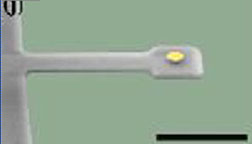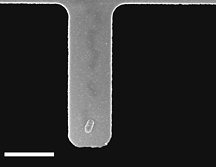Home > News > Old Company Press Releases > Cornell University News
Cornell researchers move beyond 'nano' to 'atto' to build a scale sensitive enough to weigh a virus
Ithaca, New York. April 2nd, 2004
Cornell University researchers already have been able to detect the mass of a single cell using submicroscopic devices. Now they're zeroing in on viruses. And the scale of their work is becoming so indescribably small that they have moved beyond the prefixes "nano" "pico" and "femto" to "atto." And just in sight is "zepto."
Members of the Cornell research group headed by engineering professor Harold Craighead report they have used tiny oscillating cantilevers to detect masses as small as 6 attograms by noting the change an added mass produces in the frequency of vibration.
Their submicroscopic devices, whose size is measured in nanometers (the width of three silicon atoms), are called nanoelectromechanical systems, or NEMS. But the masses they measure are now down to attograms. The mass of a small virus, for example, is about 10 attograms. An attogram is one-thousandth of a femtogram, which is one-thousandth of a picogram, which is one-thousandth of a nanogram, which is a billionth of a gram.
The work is an extension of earlier experiments that detected masses in the femtogram range, including a single E. coli bacterium, which recorded a mass of about 665 femtograms. For the latest experiments, the sensitivity of the measurement was increased by reducing the size of the NEMS cantilevers and enclosing them in a vacuum. Eventually, the researchers say, the technology could be used to detect and identify microorganisms and biological molecules.
The latest experiment by Craighead and graduate research assistant Rob Ilic is reported in the latest (April 1), issue of the Journal of Applied Physics.
The researchers manufactured the tiny cantilevers out of silicon and silicon nitride. Imagine a diving board 4 micrometers long and 500 nanometers wide. Just as a diving board will vibrate if you jump on it, these tiny cantilevers can be set into motion by an applied electric field, or by hitting them with a laser. The frequency of vibration can be measured by shining a laser light on the device and observing changing reflection of the light. The technology is similar to that used last year in playing the newest version of the Cornell nanoguitar, built to demonstrate the potential of nanofabrication.
The frequency of vibration of an object is, among other things, a function of mass: A heavy guitar string vibrates more slowly than a light one and produces a lower tone. These tiny cantilevers vibrate at radio frequencies, in the 1 to 15 megahertz range, and because they are so small to begin with, adding just a tiny bit more mass will make a measurable change in frequency.
For cell detection, the researchers coated their cantilevers with antibodies that bind to E. coli bacteria, then bathed the devices in a solution containing the cells. Some of the cells were bound to the surface, and the additional mass changed the frequency of vibration. In one case just one cell happened to bond to a cantilever, and it was possible to detect the mass of the single cell.
Antibodies also have been used to bind virus particles or proteins to a cantilever, the researchers say, but for the experiment reported in the Journal of Applied Physics, they attached tiny gold dots as small as 50 nanometers in diameter to the ends of the cantilevers. The dots then were exposed to a sulfur-based organic chemical that naturally binds to gold, which formed a single layer of a few hundred molecules on the surfaces of the dots. From the frequency shift that resulted, the researchers calculated that the mass added to a typical 50-nanometer gold dot was 6.3 attograms.
After testing various cantilever lengths and another type of oscillator suspended between two points, they calculated that the minimum resolvable mass would be .37 of an attogram. They said that with refinements, the devices could be extended to the zeptogram range, or one one-thousandth of an attogram. The sensitivity is such that the devices could be used to detect and identify DNA molecules, proteins and other biological molecules by coating the cantilevers with appropriate antibodies or other materials that would bind to the targets. Ilic already reports that "we have done viruses," although that achievement is not reported in the current paper.
Co-authors of the Journal of Applied Physics paper are Christopher Ober, the F.N. Bard Professor of Metallurgical Engineering at Cornell; Cornell graduate research assistant Wageesha Senaratne; S. Krylovof Tel Aviv University; and P. Neuzil of the Institute of Bioengineering and Nanotechnology in Singapore. The experiments that detected masses in the femtogram range were described in the Nov./Dec. 2001 issue of the Journal of Vacuum Science and Technology by Ilic, Cornell graduate student David Czaplewski, research associate Maxim Zalalutdinov, Craighead, Neuzil, Cornell graduate student Christine Capagnolo and Carl Batt, Liberty Hyde Bailey Professor of Food Science at Cornell.
The research was a project of Cornell's National Science Foundation (NSF)-supported Nanobiotechnology Center, using the equipment of the Cornell Nanoscale Facility, also funded by the NSF.
Related World Wide Web sites:
The Craighead Research Group: www.hgc.cornell.edu
Contact:
Contact: Bill Steele
Office: 607-255-7164
Copyright Cornell University
If you have a comment, please
us.
|
|
||
|
|
||
| The latest news from around the world, FREE | ||
|
|
||
|
|
||
| Premium Products | ||
|
|
||
|
Only the news you want to read!
Learn More |
||
|
|
||
|
Full-service, expert consulting
Learn More |
||
|
|
||

